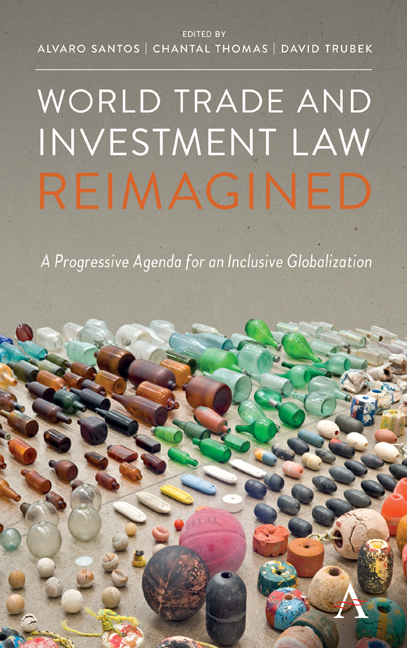Book contents
- Frontmatter
- Contents
- Acknowledgments
- List of Contributors
- Introduction World Trade and Investment Law in a Time of Crisis: Distribution, Development and Social Protection
- PART I RETHINKING THE POLITICAL ECONOMY OF TRADE: COMMENTS ON DANI RODRIK'S STRAIGHT TALK ON TRADE
- PART II SETTING THE STAGE FOR A PROGRESSIVE VISION: EMERGING ISSUES IN WORLD TRADE AND INVESTMENT LAW
- SECTION 1 MAPPING THE NEW CONTEXT FOR TRADE AND INVESTMENT LAW
- SECTION 2 DEALING WITH MAJOR CHANGES IN THE WORLD ECONOMY
- SECTION 3 FRAMING A MORE EQUITABLE INVESTMENT LAW REGIME
- SECTION 4 SUPPORTING DEVELOPMENT
- SECTION 5 REINFORCING SOCIAL PROTECTION: SPREADING THE BENEFITS OF TRADE, DEALING WITH LOSSES AND EXPLORING THE TRADE–IMMIGRATION NEXUS
- Chapter Nineteen Trade Agreements in the Twenty-First Century: Rethinking the Trade–Labor Linkage
- Chapter Twenty The New Frontier for Labor in Trade Agreements
- Chapter Twenty-One Re-embedding Liberalism: Introducing Passporting Fees for Free Trade
- Chapter Twenty-Two Restoring Trade's Social Contract in the United States
- Chapter Twenty-Three Migration and International Economic Asymmetry
- Index
Chapter Twenty - The New Frontier for Labor in Trade Agreements
from SECTION 5 - REINFORCING SOCIAL PROTECTION: SPREADING THE BENEFITS OF TRADE, DEALING WITH LOSSES AND EXPLORING THE TRADE–IMMIGRATION NEXUS
Published online by Cambridge University Press: 07 September 2019
- Frontmatter
- Contents
- Acknowledgments
- List of Contributors
- Introduction World Trade and Investment Law in a Time of Crisis: Distribution, Development and Social Protection
- PART I RETHINKING THE POLITICAL ECONOMY OF TRADE: COMMENTS ON DANI RODRIK'S STRAIGHT TALK ON TRADE
- PART II SETTING THE STAGE FOR A PROGRESSIVE VISION: EMERGING ISSUES IN WORLD TRADE AND INVESTMENT LAW
- SECTION 1 MAPPING THE NEW CONTEXT FOR TRADE AND INVESTMENT LAW
- SECTION 2 DEALING WITH MAJOR CHANGES IN THE WORLD ECONOMY
- SECTION 3 FRAMING A MORE EQUITABLE INVESTMENT LAW REGIME
- SECTION 4 SUPPORTING DEVELOPMENT
- SECTION 5 REINFORCING SOCIAL PROTECTION: SPREADING THE BENEFITS OF TRADE, DEALING WITH LOSSES AND EXPLORING THE TRADE–IMMIGRATION NEXUS
- Chapter Nineteen Trade Agreements in the Twenty-First Century: Rethinking the Trade–Labor Linkage
- Chapter Twenty The New Frontier for Labor in Trade Agreements
- Chapter Twenty-One Re-embedding Liberalism: Introducing Passporting Fees for Free Trade
- Chapter Twenty-Two Restoring Trade's Social Contract in the United States
- Chapter Twenty-Three Migration and International Economic Asymmetry
- Index
Summary
In the spring of 2015, I took my students of international trade law to visit the World Trade Organization (WTO) in Geneva. It was a two-day trip, organized around lectures and discussions with staff from different divisions of the organization, the Advisory Centre of WTO Law and the permanent missions of two countries. None of my students had been there before, and even though I had taught international trade law for several years, it was also my first time visiting the headquarters of the organization. We were excited and curious. The building looked big and majestic. The backside opened to a spacious park overlooking Lake Geneva. It made for a pleasant tour on a cool, sunny morning. The WTO was celebrating its twentieth anniversary, and there were banners hanging from the walls in the internal atrium marking the occasion, as well as announcements of events to come.
In our second session, we were led to a room with wooden panels and a colorful mural that spanned the four walls. It depicted industrial workers— strong men making a car, miners, shipbuilders, men using heavy equipment, but also women, seamstresses, teachers and a few children. In the center a bare-chested man between two goddess-like women was holding a torch. The mural struck me as an ode to work, to achievement and to emancipation. A tale of the human race transforming the world through physical and intellectual labor. The painting, by Dean Cornwell, reminded me of the frescos of Mexican artist Diego Rivera in its depiction of industrial workers, although this one had no reference to exploitation or the confrontation between capital and labor. It was an incredibly optimistic image of work and human progress.
I was surprised to see a mural of workers in the WTO. The painting seemed not only vintage but also out of place. What was it doing here? We learned that the mural had been hidden for years and it was only in 2007 that it was discovered and unveiled. It turned out that the building had been the headquarters of the International Labour Organization (ILO), and when the ILO moved to another building in Geneva in 1975, the General Agreement on Tariffs and Trade (GATT) moved in. When the WTO was created in 1995, it took its place.
- Type
- Chapter
- Information
- World Trade and Investment Law ReimaginedA Progressive Agenda for an Inclusive Globalization, pp. 215 - 224Publisher: Anthem PressPrint publication year: 2019



